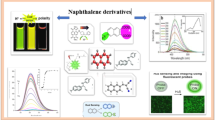Abstract
Quenching of the triplet state of eosin by thionine in water in the absence and in presence of cucurbit[7,8]urils has been studied by measuring phosphorescence, delayed fluorescence, and triplet–triplet absorption. The quenching is due to triplet–triplet (T–T) energy transfer between eosin (energy donor) and thionine, as well as its monomeric (with cucurbit[7]uril, CB7) and dimeric (with cucurbit[8]uril, CB8) complexes (energy acceptors) in deoxygenated aqueous solution at room temperature. The value of the quenching rate constant of phosphorescence, delayed fluorescence, and the triplet state of eosin by free (unbound) thionine is 3.8 × 109 L mol–1 s–1. Triplet–triplet energy transfer between eosin and the monomeric complex of thionine with CB7 occurs with a rate constant of 3.7 × 109 L mol–1 s–1. The triplet–triplet transfer between eosin and dimeric complexes of thionine with CB8, measured by quenching of delayed fluorescence and phosphorescence, occurs with a rate constant of 8.3 × 109 L mol–1 s–1. The energy transfer according to the triplet–triplet absorption data occurs with a rate constant of 8.7 × 109 L mol–1 s–1. The different effect of cucurbit[7]uril and cucurbit[8]uril on the quenching efficiency is due to the structural features of the monomeric and dimeric complexes of thionine, as well as to the value of the Coulomb interaction between the eosin anion and the cation of monomeric and dication of dimeric complexes. The observed differences in the values of quenching rate constants can be due to the different shape and extension of the molecular orbitals of the monomeric and dimeric complexes of thionine, which leads to different overlapping of the energy donor and acceptor wave functions.



Similar content being viewed by others
REFERENCES
Chibisov, A.K., Khim. Vys. Energ., 1976, vol. 10, no. 1, p. 3.
Ermolaev, V.L., Bodunov, E.N., Sveshnikova, E.B., and Shakhverdov, T.A., Bezyzluchatel’nyi perenos energii elektronnogo vozbuzhdeniya (Nonradiative Electronic-Excitation Energy Transfer), Leningrad: Nauka, 1977.
Zakharova, G.V., Korobov, V.E., and Chibisov, A.K., Teor. Eksp. Khim., 1982, vol. 18, no. 3, p. 343.
Chibisov, A.K., Usp. Khim., 1981, vol. 50, no. 7, p. 1169.
Korobov, V.E. and Chibisov, A.K., Usp. Khim., 1983, vol. 52, no. 1, p. 43.
Chibisov, A.K., Prog. React. Kinet., 1984, vol. 13, p. 1.
Dexter, D.L., J. Phys. Chem., 1953, no. 5, p. 836.
Zakharova, G.V., Avakyan, V.G., Markelov, V.P, et al., High Energy Chem., 2015, vol. 49, no. 6, p. 407.
Zwicker, E.F. and Grosweiner, L.I., J. Phys. Chem., 1963, vol. 67, p. 549.
Kasche, V. and Lindqvist, L., Photochem. Photobiol., 1965, vol. 4, p. 923.
Zakharova, G.V., Lifanov, Yu.I., and Chibisov, A.K., Zh. Anal. Khim., 1980, vol. 35, no. 10, p. 1905.
Zakharova, G.V. and Chibisov, A.K., Khim. Vys. Energ., 1984, vol. 18, no. 6, p. 552.
Montes-Navajas, P., Corma, A., and Garcia, H., Chem. Phys. Chem, 2008, vol. 9, p. 713.
Montes-Navajas, P. and Garcia, H., Photochem. Photobiol., 2009, vol. 204, p. 97.
Xi, Y.Y., Tang, Q., Huang, Y., Tao, Z., Xue, S.F., and Zhu, Q.J., Spectrosc. Spectral Anal., 2016, vol. 36, no. 6, p. 1809.
Atabekyan, L.S., Avakyan, V.G., Zakharova, G.V., and Chibisov, A.K., High Energy Chem., 2018, vol. 52, no. 2, p. 117.
ACKNOWLEDGMENTS
The work was financially supported by the Ministry of Science and Higher Education under the State Assignment of the Photochemistry Center “Crystallography and Photonics” of the Russian Academy of Sciences for the measurements of the kinetic decay curves of delayed fluorescence and phosphorescence, and the Russian Foundation for Basic Research for spectral and luminescent measurements (project no. 18-03-00183) and laser-kinetic measurements (project no. 16-29-11765 ofi_m).
Author information
Authors and Affiliations
Corresponding authors
Additional information
Translated by A. Tatikolov
Rights and permissions
About this article
Cite this article
Fedotova, T.V., Gutrov, V.N., Zakharova, G.V. et al. Triplet–Triplet Energy Transfer as a Reason for Quenching by Thionine of the Triplet State of Eosin in Complexes with Cucurbit[7, 8]urils in Water. High Energy Chem 53, 22–25 (2019). https://doi.org/10.1134/S0018143919010041
Received:
Revised:
Accepted:
Published:
Issue Date:
DOI: https://doi.org/10.1134/S0018143919010041




